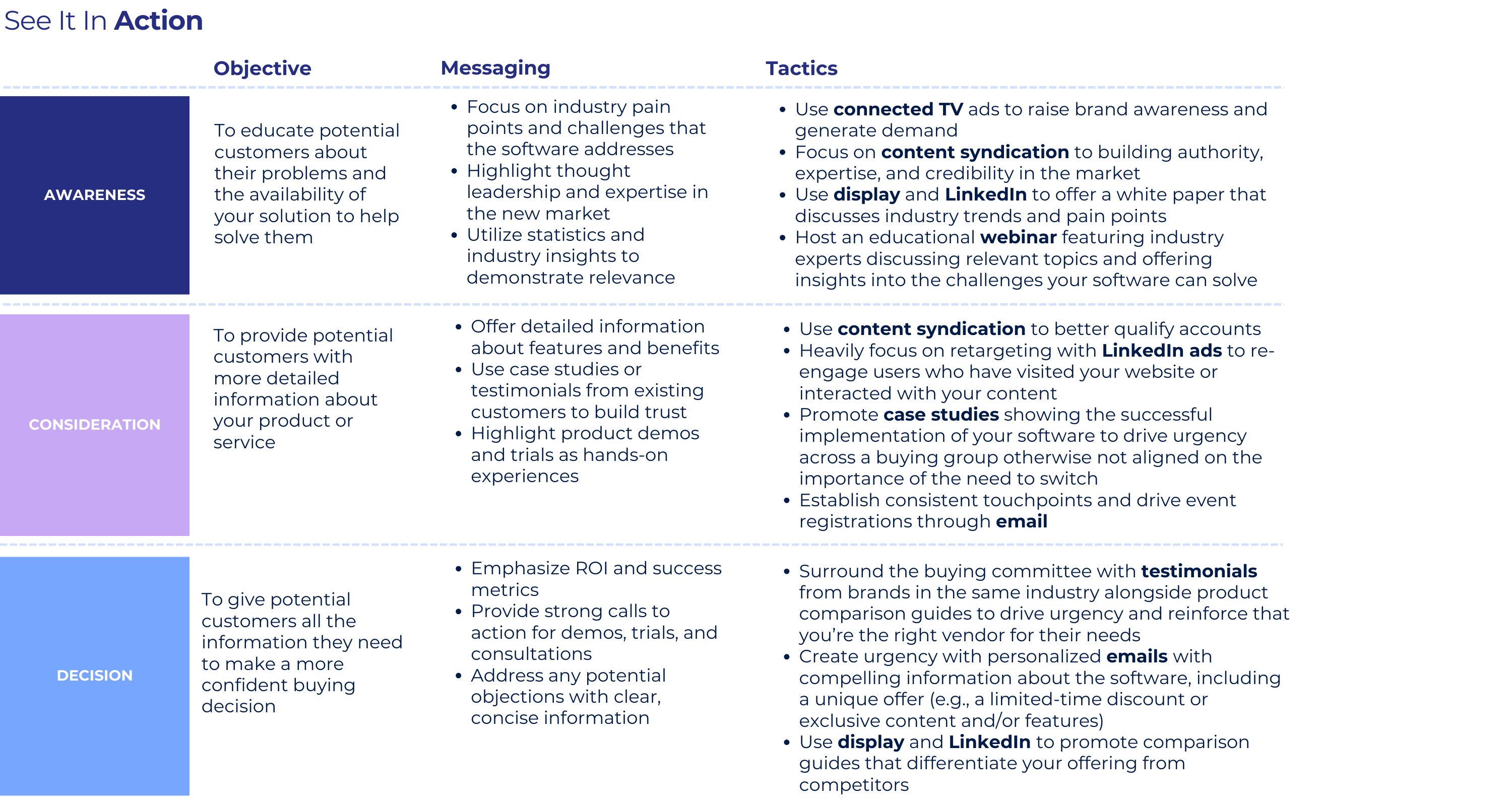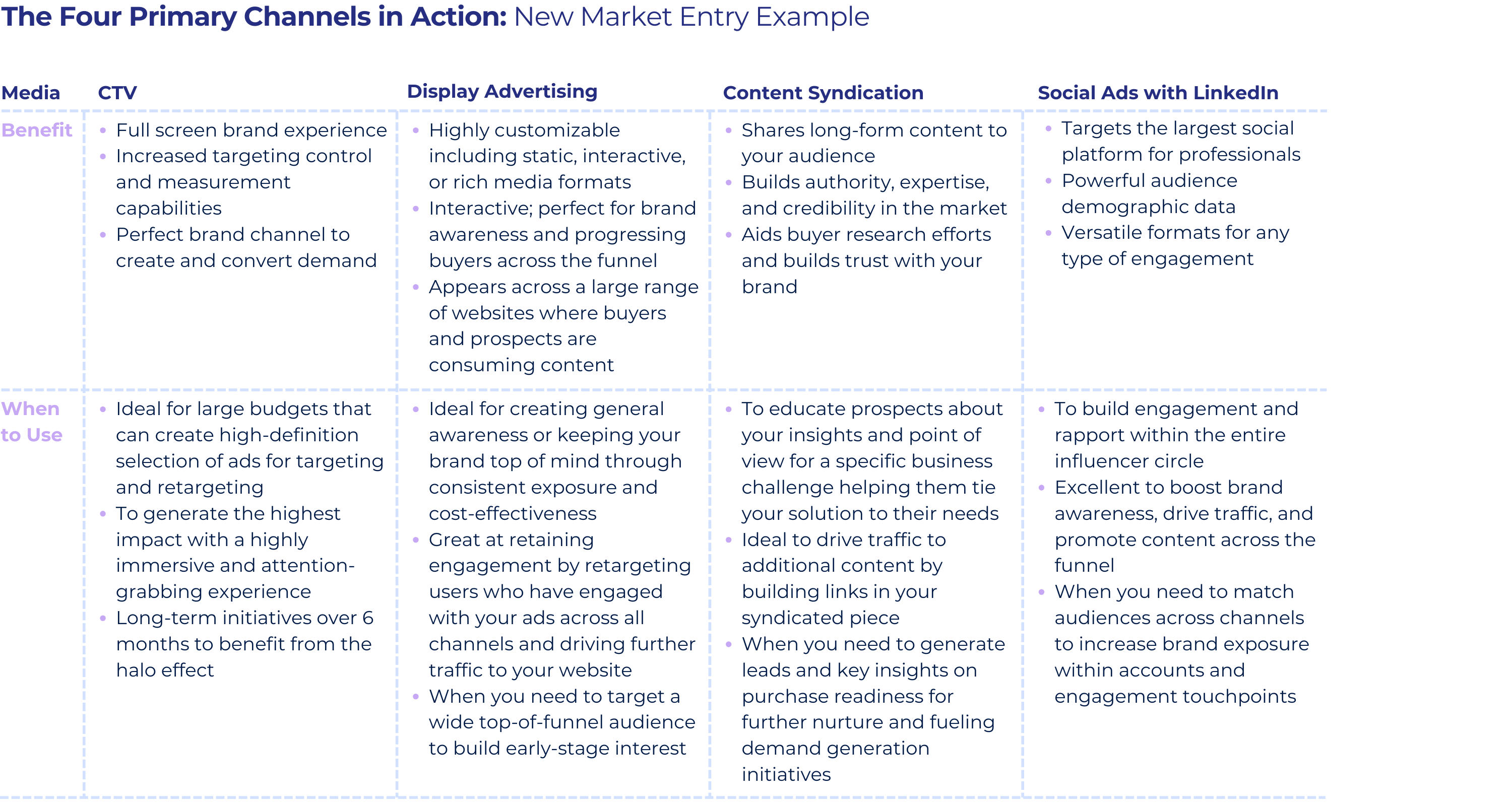
Whether it’s your first product, an additional feature for your existing product, or a new product vertical, you need to know how to introduce it to your target audience.
Your target audience may have familiarity with your brand or none at all. Even if brand visibility is high, your audience may not even realize you offer a solution that fulfils their needs. And while brand awareness initiatives require heavy resource investment, it’s worth it: Forrester’s 2023 Business Trust Survey notes that over three-fourths of surveyed decision-makers factor in brand awareness when it comes to trusting an organization. Being a brand that buyers trust and are familiar with speeds up the sales cycle—and even if buyers aren’t currently in-market, strong brand presence makes it more likely for them to look you up when they’re ready to explore new or emerging solutions.
Once you have your buyers’ attention, you need to keep it and urge them to move through your sales funnel. But the buyer’s journey isn’t linear. Buyers are human, after all, and can get swept away from exploring your solution due to shifts in priorities and market & industry conditions. Yet with account-based marketing (ABM), using a multi-channel approach and strong nurture strategy, you can build a strong foundation for a journey that is personalized and has buyers’ priorities and interests front and center. Here’s how.
Why an ABM Approach Benefits Your Product Marketing Throughout the Sales Funnel
The journey from awareness to decision often involves multiple touchpoints and buying committee members progress through the funnel at different speeds. An always-on ABM program is critical to keeping your ABM content and messaging in front of your prospects.
As much as marketers try to map the buyer’s journey and nurture paths out, there are people behind those buying decisions. While ideal customer profiles (ICPs) and target account lists can provide insight into the organizations, accounts, and buyer personas to expect on the buying committee, it’s human nature to be unpredictable and frequently change our minds.
It’s up to marketing and the sales team to align on and determine what buyer behaviors and actions indicate a shift from brand building to readiness for content that drives demand. An always–on, multi–channel ABM strategy makes sure that you surround potential customers with content that delivers the right message exactly where they are and when they need it to continue engagement and drive urgency toward product demand.
How to Choose Your Media Mix Based on the 3 Buying Stages
In a new market entry campaign, every stage of the sales funnel benefits from brand awareness initiatives. You need to look at your marketing media mix to determine how your content aligns with each channel, and how your new market entry campaign can most likely benefit from a multi-channel approach.
Potential customers and later–stage decision–makers (such as C–suite executives) can forget your brand in an overly saturated market, or not know your brand exists within that product vertical at all. You need to build brand awareness into every stage of the buying journey, as these decision–makers will most likely not be as familiar with your offerings but are being introduced to your product by the end-users in the buying committee who would use your product every day.
According to Gartner, there are, on average, 14-23 members in a buying group. Focusing brand awareness initiatives on accounts through all your channels is key to strengthening your brand visibility across all the decision-makers. Here’s how you can approach brand building and demand generation across the sales funnel.
Brand Building in the Awareness Stage
Brand building at the awareness stage focuses on information and education. Your target audience needs to identify that they have problems that need solutions. Your channel and content distribution strategy should focus on targeted outreach that encourages buyer engagement with top-of-funnel collateral and sets buyers up to enthusiastically move deeper into the funnel with the same or more enthusiastic level of interest.
White papers, analyst reports, and eBooks are perfect assets to share through content syndication, which expands your reach beyond your website or social platforms. Active buyers want information on market conditions, industry trends, and solutions to their challenges.
Yet to remain truly top of mind, you need to utilize other channels to ensure you surround your buyers with your messaging wherever you are. Programs combining content syndication with display advertising, for example, improve conversion rates 2.6x compared to content syndication running alone. Accounts converting with content syndication and connected TV (CTV)—which is a prime brand awareness channel due to 80% of U.S. viewers using at least one streaming TV service overall—shows a 2x increase in awareness and research, as opposed to accounts targeted without CTV.

Make sure that your content has consistent design alongside hitting your key messaging points. Your brand colors, logo, and any unique design elements help build a relationship with your brand, as they’ll associate these elements as part of the quality relationship you’re hoping to build with them.
Brand Building in the Consideration Stage
At the consideration stage, your content should deliver more detailed product information. “More details” doesn’t mean on product functionality alone; you need to make it clear why your offering stands out against your competitors.
Content needs to drive urgency while reinforcing your brand and why your offering is the perfect solution for specific pain points. Your lead scoring model will continue to play an important role at this stage, as you want to focus on how you can drive conversations and move leads to meet with the sales team. Marketing can focus on deeper qualification of marketing–qualified leads (MQLs) with content syndication and retargeting ads to sustain engagement. Sales and marketing can collaborate on email and events messaging, since these channels encourage direct interaction.
Brand Building in the Decision Stage
At the decision stage, potential customers require comprehensive, digestible bits of information that they can show other decision-makers. Your content needs to reinforce your reputation and show that you are the optimal choice for your buyers’ needs. Not only does your content need to demonstrate that your solution can solve immediate problems, but that you have a proactive outlook that will continue to keep customers’ needs in mind as the industry and marketplace change.
Targeted display ads extend your brand’s presence, delivering tailored messaging to address key purchase questions or product differentiation points and benefits. Customer success stories and testimonials serve as pivotal to solidifying your brand reputation in a new market. Buyers trust word of mouth, especially when they respect the brands that work with your product. Deliver video testimonials to your audience via CTV, display ads, or LinkedIn, as these channels help keep you top of mind while further reinforcing your written case studies and other messaging available on your website that displays customers’ achievements and how your solution helped drive effective results.
Demand Generation at the Consideration and Decision Stages
Of course, you can’t forget the demand generation efforts throughout the consideration and decision stages.
At the consideration phase, you can easily transition from brand awareness to demand through display ads and LinkedIn Ads, which help keep your product top of mind while accelerating engagement. Demo videos or customer testimonials can serve as ads that demonstrate real-world applications and benefits. Email marketing is also a beneficial channel at this time, as you can track engagement through open and click-through rates on newsletters and emails. Focus on sharing information about product developments and opportunities to explore your product and engage with your sales team at events and webinars.
In the decision stage, expedite decision-making processes by targeting executive personas with content syndication. Comparison guides, product sheets, and white papers are especially effective to underscore your product’s advantages over competitors.
Paid media channels complement some of the other brand and demand initiatives, such as public relations, events, and webinars. Investing in paid media provides additional visibility and engagement opportunities to highly targeted segments within your new market target account list, and lift the performance of your other efforts as buyers and prospects are increasingly exposed to your brand and content.
See It in Action: How to Market a Product Example
Content is everywhere, from your website to live events. It’s up to marketers to discover opportunities to amplify content and messaging in multiple ways, especially when the organization is breaking into a new market.
Your marketing strategy is most likely multi-faceted. Your digital marketing strategy may consist of weekly articles that undergo search engine optimization (SEO) so that you can gain organic search traffic and get more eyes on your content. Your content marketing strategy may also include opinionated articles, which allow your organization’s thought leaders to share their insights on market trends and industry news. Your social media marketing strategy may include B2B influencer marketing so that you can quickly build rapport and recognition. Sales and customer success teams are most likely engaging loyal customers within the customer base for user-generated content, such as case studies and testimonials to publish on the website directly or customer reviews on sites like G2 and TrustRadius, so that new customers may gain reassurance that they chose the right partner for their needs. And your product marketing strategy most likely analyzes those reviews and ratings to prioritize product features and optimizations within the production pipeline.
All of these strategies come together as one big account-based marketing plan. To put that plan into action requires deep, strategic thinking around how to distribute content and how to gain more content so marketing campaigns don’t lose their vigor. Each marketing channel has different stipulations and prioritizes different formats. At the same time, buyers prefer particular channels and formats. Some decision-makers may want to view a video over reading something. Yet longer videos, like webinars, may not get to what that decision-maker cares about until 40 minutes in. It doesn’t mean the webinar isn’t valuable—it just means you need to understand how to make the most of your content so your messaging reaches buyers exactly when they need it.
Repurposing your content is a great content marketing strategy to sustain engagement over time without needing a slew of new resources. Take portions of white papers to write blog articles or excerpt in your sales outreach efforts. Case studies can be broken into static images to use for display advertisements or LinkedIn Ads. Break webinar videos apart to use as part of your CTV, display ad, and LinkedIn ad strategy. What was once one piece of content can easily break out into multiple pieces, optimized for each channel and buyer persona.


Engage Your Buyers Better with Madison Logic
Crafting a near perfect buyer’s journey for a new product launch is quite the undertaking. But you don’t need to waste precious resources with constant market research, writing, and optimization of assets and ABM campaigns. We created the New Horizons: Navigating New Market Entry with ABM Blueprint to help you quickly build brand awareness and get the marketplace buzzing about your entry.
The Blueprint offers deeper insight into how an ABM strategy can help accelerate the impact of your marketing motions. Yet to make the most of an ABM strategy, you need a partner that can bring your vital datasets into one holistic view so that you can continue to provide fantastic service and offerings to your current and future customers. When you partner with Madison Logic, you gain access to ML Insights, our proprietary intent data from over 20 billion companies, our proprietary engagement data from the four primary marketing channels (content syndication, display advertising, CTV, and LinkedIn), and third party B2B research data. These data sources allow you to:
- Identify buying committee demographics so you can match them with engaging content and messaging
- Uncover behavioral insights across marketing channels so you can optimize your channel strategies
- Optimize campaigns with new content based on product research, content engagement, and account data
- Calibrate your lead scoring model to proactively act on buyer behavior and engagement
ML Measurement reinforces proactive insights, as it quickly calibrates marketing’s impact on pipeline and return on investment (ROI). You can also dive into target accounts’ activities across channels and buying stages, compare them to your campaign benchmarks, and optimize campaigns for stronger performance.
Request a demo to learn more about Madison Logic today.


